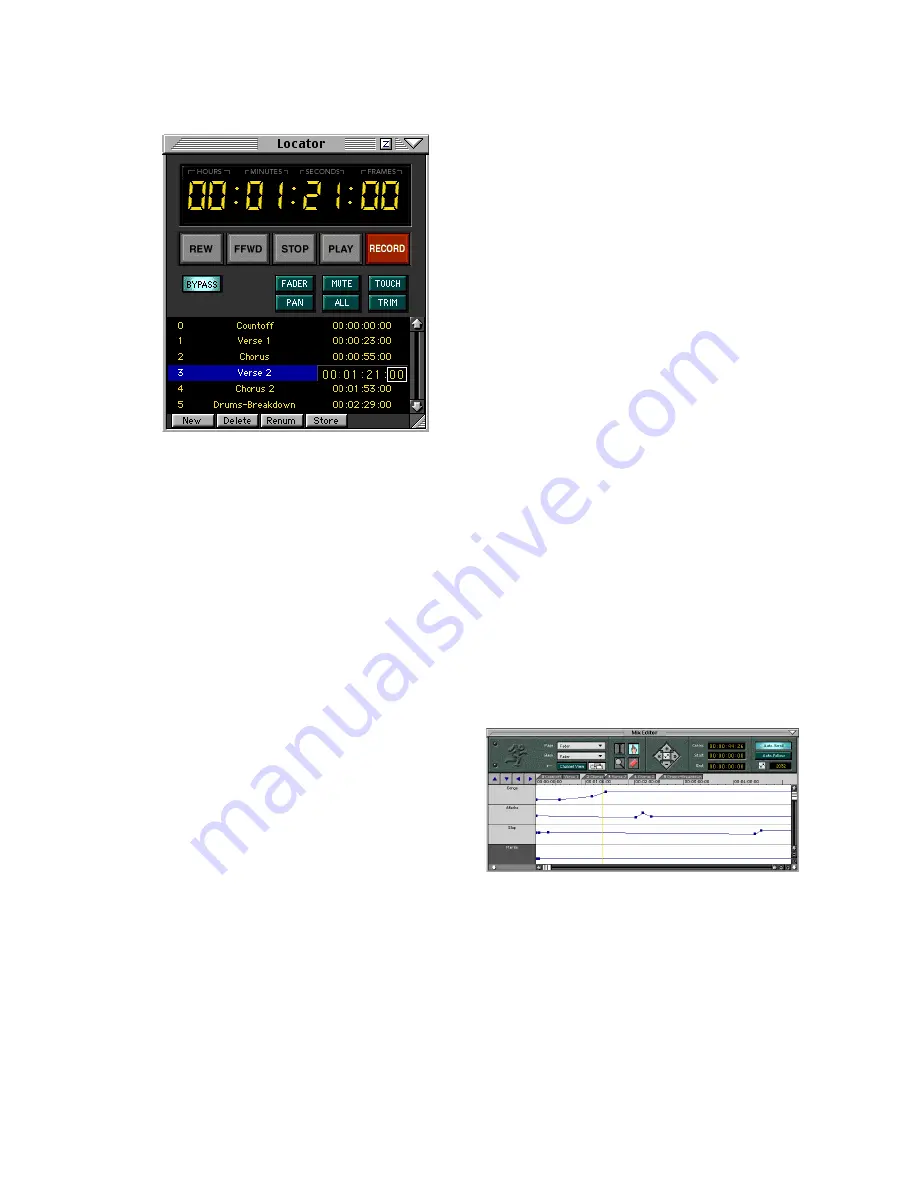
D8B Manual • Chapter 3 • page 75
LOCATOR Parameters
New
• Click this button to create a new cue point.
• The new cue point is created at the existing
SMPTE, millisecond, or measure position.
• Cue point readout changes form depending on the
readout format selected in the main Locator
window (SMPTE, Bars, Milliseconds.)
Delete
• Click this button to Delete the highlighted cue
point(s) from the Cue list.
Renum
• Cue points are ordered on the Cue list according
to their Locator position (SMPTE, Bars,
Milliseconds). If cue points are not created
progressively from the beginning of the recording
to the end, the Locator numbers (left of the Cue
name) might become random. Click Renum to
restructure the cue numbers into ascending order
from the beginning of the recording to the end.
Store
• Click Store to enter the current Locator position
into the highlighted Cue point.
• If multiple cue points are highlighted, the Locator
position is stored in the earliest occurring Cue
point only.
The Mix Editor Window (Ctrl+5)
The Mix Editor window contains a graphic
representation of automation data. Though
automation data is primarily entered through the
control surface knobs, buttons, and faders, it can
also be altered graphically in the Mix Editor.
Precise level and timing information is easily
entered and adjusted here. The resizable window
supports various selectable views from 1 to 24
channels, or parameters, of data on the Y axis and
any length of time region on the X axis (up to 24
hours). A vertical scroll bar allows for paging or
incremental viewing of the channels or parame-
ters, and the horizontal scroll bar allows for
paging or scrolling time chunks, according to the
current time resolution.
The Mix Editor can view a single channel with
all of its parameters or, by selecting the “Channel
View” checkbox, you can view multiple channels
of one parameter type (plus a background event of
a different type). This allows you to view, for
example, 12 EQ parameter tracks stacked on top
of one another, or 6 stacked pan automation
curves.
Automation Event curves are displayed as
dots (actually, small squares) that represent
nodes, and lines that represent value ramping.
The nodes represent editable points that are either
created during the automation process in real
time, or by the hand tool in the Mix Editor.
Note that on/off or radio button-type param-
eters (e.g., Mutes, EQ On/Off, or Snapshots, etc.)
that aren’t of a ramping type, are displayed as
stepped values.
Automation tracks may be cut, copied and
pasted, in typical graphic editor fashion, using
click and drag highlighting with the mouse cursor
and ` (“I” icon). Single segment copy and multiple
pasting may be performed easily with repeatable
segments for a “groove” repetition approach. An
entire time region across all parameters or
channels (according to the current filter views)
may be selected by clicking and dragging across
the top time bar. Highlighted regions may be
“nudged” up, down, left or right, for trim or offset
needs, using the 4 nudge arrows (top center of the
Mix Editor window).
Note:
Refer to the History List as well. It’s of
great value when using the Mix Editor.
Auto Follow
• This feature causes the Mix Editor to change
views on the fly. When enabled, Auto Follow
updates the Mix Editor to focus on any parameter
you touch (by channel and function). When
enabled, “Auto Scroll” updates the Mix Editor to
scroll the screen past the timeline cursor, located
at the screen’s halfway point.
Edit Tools
Left-click on the Mix Editor tools to select
them. At any time, right-click in the channel/
parameter list to open a pop-up list for quick and
Summary of Contents for D8B 3.0
Page 8: ...D8B Manual Preface page 2 ...
Page 9: ...D8B Manual Chapter 1 page 3 Chapter 1 Getting Ready ...
Page 27: ...D8B Manual Chapter 2 page 21 Chapter 2 Where Is It ...
Page 47: ...D8B Manual Chapter 3 page 41 Chapter 3 What s On TV ...
Page 93: ...D8B Manual Chapter 4 page 87 Chapter 4 Applications ...






























